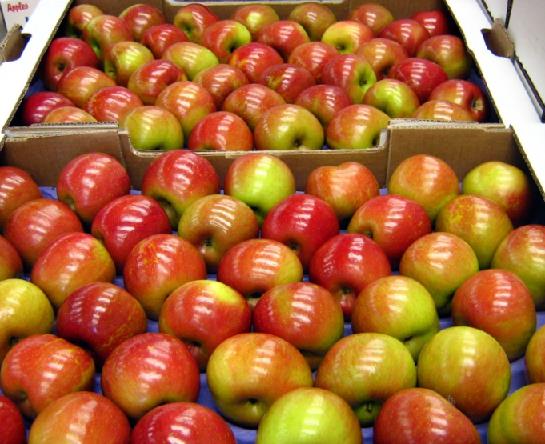In a rapidly evolving global fruit industry, Chile stands on the brink of introducing a new variety of apples aimed specifically at the export markets in China and Japan. The Program for Associative Genetic Improvement of Apple Trees (PMG), spearheaded by the Pomáceas Center at the University of Talca, is leading this charge. According to Daniela Simeone, the coordinator of PMG, this new variety could soon become a reality: “We expect that in the coming years we will have a new Chilean variety of apple trees, not only for Chile but for the world.”
This development comes at a time when consumer preferences for apples have shifted significantly. While in the past, the demand was for more acidic apples, today’s consumers are increasingly seeking sweeter varieties. These changing preferences have led PMG, supported by CORFO through Biofrutales, International Fruit Obtention (IFO), and A.N.A. Chile, to adjust their focus and cater to the needs of key export markets like China and Japan.
Shift in Focus: From Northern Europe to the Far East
Initially, PMG focused on developing apple varieties for Northern Europe, where consumers have historically favored slightly more acidic apples. However, as consumer tastes have evolved, the PMG program has shifted its focus towards developing sweeter apples that are in high demand in Asian markets, particularly in China and Japan. Simeone notes: “In the beginning, the PMG was focused on finding apples for Northern Europe, a region that has traditionally preferred more acidic varieties. However, over time, consumer preferences have changed, and we have started to select sweeter apples, which are very popular in Eastern markets such as China and Japan.”
To date, the PMG has made significant progress in its apple breeding efforts. A total of 434 hybrids with desirable characteristics at the time of harvest have been selected, of which 46 have advanced to the Intermediate Selection (SI) stage. At this stage, the hybrids are propagated and planted in evaluation modules in locations such as Chimbarongo, Molina, Pelarco, Linares, and Angol.
Intermediate and Advanced Selection Stages
During the Intermediate Selection stage, various plant and fruit characteristics are evaluated to ensure that the traits for which the hybrids were selected are heritable. Out of the 46 SI hybrids, five have been promoted to the Advanced Selection (SA) stage, where a larger number of individuals are propagated and planted in pre-commercial modules, primarily located in Chimbarongo, Molina, and Angol.
“In this stage, a detailed description of the agronomic behavior of the trees and the fruit is made, and sensory panels are carried out to assess the potential of each selection to become a new apple variety,” Simeone explains. “Of the five SA hybrids evaluated, at least two have received very positive feedback in the tasting panels. Therefore, we believe that we will soon have a new apple variety.”
Characteristics of the New Apple Varieties
The new apple varieties being developed by the PMG are selected for their high organoleptic quality and appearance. According to Simeone, these apples must be adapted to warm climates with high solar radiation, a key factor given the growing conditions in Chile. Additionally, the varieties must exhibit high productivity and avoid alternate bearing, a common issue where trees produce significantly less fruit in alternating years.
In terms of organoleptic and visual attributes, the apples must have a bright red color, high sweetness with a slight acidity to enhance flavors, and possess a fine, juicy, and crunchy pulp—similar to the texture of watermelon flesh. These characteristics are essential for meeting the preferences of consumers in China and Japan, where the demand for visually appealing, sweet apples is high.
Challenges Facing the Chilean Apple Industry
Despite the promising progress made by the PMG in developing new apple varieties, the Chilean apple industry is facing one of its most challenging periods. Exporters and industry consultants point to rising costs and declining demand in key markets, which have led to significant losses for producers. This has resulted in the abandonment of apple orchards by some farmers and has forced those who remain in the industry to seek new strategies to turn their finances around. Among these strategies are investments in varietal improvement, genetic research, and new technologies.
According to Simeone, the development of new apple varieties tailored to the challenges of the Chilean growing environment could help producers mitigate the losses they have faced in recent years. However, she stresses that marketing and positioning these new varieties in target markets will be crucial to the success of these initiatives. “Having varieties selected under these conditions can help producers reduce the losses they have faced in recent years,” Simeone says. “However, the marketing and positioning of these varieties in their target markets is fundamental to the success of these efforts.”
Addressing the Industry’s Most Pressing Needs
The Chilean apple industry has traditionally relied on varieties developed and selected abroad, often from regions with less stressful climatic conditions than those found in Chile. This has led to challenges for Chilean growers, as many of these foreign varieties do not perform well in the extreme conditions of high radiation, temperature, and humidity that characterize the apple-growing regions of Chile.
“The apple industry has been developed with varieties that have been evaluated and selected abroad, often from regions with less extreme climatic conditions than our own,” Simeone explains. “This is why many investment projects have failed in recent years—because there hasn’t always been sufficient research into how these varieties behave in regions with high radiation, temperature, and humidity, which are the prevailing climatic conditions in Chile’s apple-growing areas.”
Innovation and Research: Keys to the Future of Chilean Apple Production
To ensure the success of the new apple varieties, the PMG program is focusing on developing apples that are not only suited to the tastes of consumers in key export markets but also well adapted to the challenging growing conditions in Chile. By doing so, the program aims to create varieties that can help Chilean apple producers maintain competitiveness in the global market, despite the difficulties they currently face.
In conclusion, the development of new apple varieties through the PMG program represents a significant opportunity for Chilean apple growers to recover from recent challenges and establish a stronger foothold in key export markets, particularly in China and Japan. With a focus on sweet, visually appealing apples that are well adapted to the Chilean climate, this initiative has the potential to transform the Chilean apple industry and ensure its long-term viability.
However, as Simeone emphasizes, the success of these efforts will depend not only on the development of high-quality varieties but also on effective marketing and positioning strategies to ensure that these new apples can thrive in their target markets. By investing in both research and promotion, Chilean apple producers can look forward to a brighter future, with new opportunities for growth and success in the global fruit industry.



